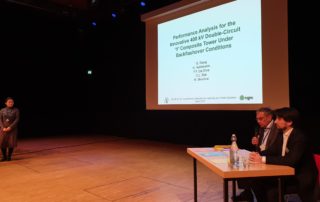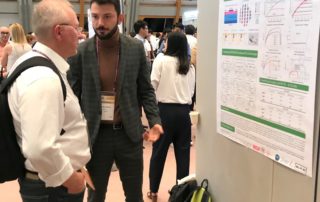Nos publications scientifiques
Requirements for interconnection of HVDC links with DC-DC converters
The number of high voltage direct current (HVDC) links continue to increase over the years, most of them, for offshore applications or bulk power transmission over long distances. The present paper evaluates the possible development of a direct current (dc) grid in Europe given the present, and future, HVDC links. Eight potential cases for the interconnection between close links are suggested as starting scenario for a multiterminal network. The need of a dc-dc converter and its special requirements are evaluated in function of suggested interconnections. As an example, a case study is chosen to evaluate the behavior of an interconnection between line commutated converter (LCC) and voltage source converter (VSC) link using a front-to-front (F2F) isolated converter.
Assessment of the Impact of Split Storage within Modular Multilevel Converter
This paper deals with the opportunities to introduce split storage into an MMC. The analysis is focused on the internal energy exchange to maintain the proper function of the converter by using circulating current. Analysis shows that, SM capacitor voltage ripple or semiconductors load are greatly influenced by additional circulating current injection. This study helps to design Embedded ESSs in the converter to provide new function like ancillary services for power system operation. Finally, a simulation of an MMC with ESS confirms analytical calculations.
Use of Unbalanced Insulation for the Limitation of Double-Pole Lightning Flashovers in Double Circuit HVDC Overhead Lines
Lightning studies are a critical part of any system involving overhead lines. As HVDC technologies develop, new problems and questions arise regarding the lightning performance of HVDC overhead lines. For instance, the installation of two separate HVDC circuits on the same transmission tower may become a popular alternative for the uprating of old AC lines to take advantage of the already existing Right-of-Ways. Double-pole flashovers may be particularly constraining in double circuit HVDC systems, since they could lead to the loss of both circuits at the same time due to the flashover of both poles of the same polarity having the same amplitude at all times (which is not the most likely case in AC systems). This corresponds to a 100% of loss of transmitted power, which could represent a threat for the system stability. This constitutes the main motivation for this work.
Interest of using a micro-meter spatial resolution to study SiC semi-conductor devices by Optical Beam Induced Current (OBIC)
In this paper we present a new test bench called micro-OBIC used to characterized wide band gap semi-conductor. Micro-OBIC allows to scan an Optical Beam Induced Current (OBIC) signal with a microscopic spatial resolution. We used micro-OBIC to characterize peripheral protection such as MESA, JTE or JTE in high voltage SiC device.
Static and Switching Characteristics of 10 kV-class SiC BJTs and Darlingtons
This paper reports the device design, fabrication and characterisation of 10 kV-class BJT. Manufactured devices have been packaged in single BJT, two paralleled BJTs and Darlington. The static and switching characteristics of the resulting devices have been measured. The BJTs (2.4mm² active area) show a specific on-resistance as low as 198 mΩ·cm² at 100 A/cm² and room temperature for a βMax of 9.6, whereas the same active area Darlington beats the unipolar limit with a specific on-resistance of 102 mΩ·cm² at 200 A/cm² (β=11) for a βMax of 69. Double pulse tests reveal state of the art switching with very sharp dV/dt and di/dt. Turn-on is operated at less than 100 ns for an EON lower than 4mJ, whereas the turn-off takes longer times due to tail current resulting in EOFF of 17.2 mJ and 50 mJ for the single BJT and Darlington respectively when operated at high current density. Excellent parallelisation have been achieved.
Liquid spray injection in the expansion volume of a CO2 high voltage circuit breaker
Most high voltage gas circuit breakers (HVCB) in operation use SF6 as the arc interruption medium because of its high dielectric strength and good arc interruption properties. However, SF6 also displays a high global warming potential which motivates the investigation of possible alternatives to this gas.
On the Black Start of Offshore Wind Power Plants with Diode Rectifier based HVDC Transmission
This paper attempts a detailed comparison of some of the solutions for black start of the Offshore Wind Power Plants with Diode Rectifier based HVDC transmission.
Influence of the operating frequency on DC-DC converters for HVDC grids
This paper proposes an analytical methodology that allows to assess rapidly the comparison of DC-DC converters. It was applied to evaluate two modular DC-DC structures, one isolated circuit and one non isolated circuit, focusing in the variation of the operating frequency for different DC voltage transformation ratios.
Power Hardware In-the-Loop validation of DC-DC power converter for offshore wind energy
he paper describes the development of a power converter small scale mock-up and a real time model of an off-shore wind farm. A Power Hardware In-the-Loop validation is proposed for a demonstration of grid architecture and control principles. The paper presents the design methodology of the PHIL test bench and underlines the contribution of PHIL in the design flow of power converter development for DC grid application. Experimental results of preliminary PHIL tests are presented.
Tuning of Droop Parameters Using Virtual Capacitor Control to Improve Voltage Dynamics
This paper proposes a new approach to tuning voltage droop parameters in an MMC-based multi-terminal HVDC system. Using the new degree of freedom offered by the virtual capacitor control, the transient behavior of the DC voltage can be improved without adverse effects on the connected AC grids.




